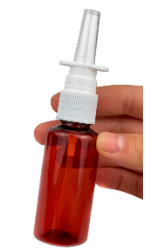
20 Jun Synapsin (Rg3 and nicotinamide riboside) in Nasal Spray or Sublingual drops
Synapsin (Rg3 and nicotinamide riboside) in Nasal Spray or Sublingual drops
Synapsin NS is a combination of a ginsenoside (Rg3) nicotinamide riboside and usually vitamin methyl B12. Synapsin® Nasal Spray is not to be confused with the synapsins that are a family of proteins (synapsin I, II, III) that have long been implicated in the regulation of neurotransmitter release at synapses between nerve cells.
Synapsin was invented by pharmacist, author, and functional medicine speaker Jim LaValle, RPh, CCN, ND, and is commonly used in combination with methylcobalamin or hydroxocobalamin (hydroxycobalamin) in formulations to support neuronal function and cognition. It is used to preserve brain function and cognition and to reduce the effects of aging on the brain.
While teaching at a university of pharmacy in Cincinnati, Ohio LaValle was approached by a visiting professor from Beijing, China. He was told that this newly discovered Rg3 from a Panax Ginseng plant was a great neural inflammation quencher.  That is how LaValle stumbled upon the idea of Synapsin for those children with autism spectrum disorder. Children with autism have a universal issue with brain inflammation. LaValle was working closely with those children with “brains on fire.” So, to put out the fire you had this new Rg3 and then you had to rebuild the damage caused by the inflammation once it was put out. That is where the nicotinamide riboside comes in. This supports and feeds the mitochondria in the neuronal cells to help rebuild neurons. The myth that neurons cannot be regenerated has been busted. It was found that nicotinamide riboside had the ability to trigger NAD production, and this supports and keeps the energy packs (mitochondria) in the cells alive and well. One of the chief contributors to disease and aging is mitochondrial death and dysfunction. Keeping the mitochondria healthy is key. A big fad right now is the use of NAD or NAD+ in an IV form. This has been purposed for use in the damaged brain from alcohol use and other toxins. The use of IV NAD+ is not simple or inexpensive. For it to be done correctly you need infusions of six-hours or more and it gets quite costly and not very accessible to most folks. NAD in a nasal spray delivery system is a very good alternative and places the compound in close proximity to the brain. That is why it makes sense to place nicotinamide riboside in with Rg3.
That is how LaValle stumbled upon the idea of Synapsin for those children with autism spectrum disorder. Children with autism have a universal issue with brain inflammation. LaValle was working closely with those children with “brains on fire.” So, to put out the fire you had this new Rg3 and then you had to rebuild the damage caused by the inflammation once it was put out. That is where the nicotinamide riboside comes in. This supports and feeds the mitochondria in the neuronal cells to help rebuild neurons. The myth that neurons cannot be regenerated has been busted. It was found that nicotinamide riboside had the ability to trigger NAD production, and this supports and keeps the energy packs (mitochondria) in the cells alive and well. One of the chief contributors to disease and aging is mitochondrial death and dysfunction. Keeping the mitochondria healthy is key. A big fad right now is the use of NAD or NAD+ in an IV form. This has been purposed for use in the damaged brain from alcohol use and other toxins. The use of IV NAD+ is not simple or inexpensive. For it to be done correctly you need infusions of six-hours or more and it gets quite costly and not very accessible to most folks. NAD in a nasal spray delivery system is a very good alternative and places the compound in close proximity to the brain. That is why it makes sense to place nicotinamide riboside in with Rg3.
Microglial activation and the inflammation that ensues seems to be central to conditions from autism to obesity. Microglial cells in the brain when modulated by Synapsin and often times with vitamin B12 (or B12a) can have a very positive effect on health across a broad spectrum of disorders in many people.
Since 2020 doctors have realized that the SARS-coV-2 virus and the COVID-19 disease has a very negative impact on the brain. Most obvious is the conditions of anosmia (loss of smell) and hypogeusia (loss of taste) but what can follow is ‘’brain fog’’ a type of cognitive decline that disallows the sufferer to think clearly, remember and process memories, and in general negatively affects executive function. COVID-19 and not to be excluded the mRNA vaccines derived to fight the pandemic appear to have an effect of increasing inflammation within the microglia cells. In the same way we see Synapsin work in patients with autism spectrum disorder and those suffering traumatic brain injury, and brain fog initiated by stressful lifestyles by corporate executives, we now see usefulness in the COVID affected. It makes intuitive sense that Synapsin would work in the COVID inflamed brain. To help put out the cytokine induced inflammation in the brain and secondly to assist the mitochondria to repair cells, Synapsin comes in as a very much needed intervention.
Along with Synapsin we need to modify lifestyle with adequate exercise and sleep. Top on the list of lifestyle modification is with diet to reduce insulin resistance and high glucose levels. Intermittent fasting (IF) and caloric restriction prevents the release of inflammatory mediators and downregulation of insulin receptors and rise in insulin levels. A condition with rising insulin, HbA1c and serum glucose levels along with a rise in leptin is referred to as Type 3 Diabetes Mellitus (T3DM). T3DM is very likely one chronic condition that can lead to Alzheimer’s diseases. IF can reduce inflammation and activate cells in the immune system that can clean up damaged or dying cells and those that are dysfunctional (a process known as autophagia). Here lies the importance of intermittent fasting as a primary intervention in the FLCCC’s post-vaccine injury protocol. A secondary intervention we provide our patients at CHM with is Synapsin NS. Additionally intranasal Oxytocin is another intervention we have seen success with in these patient populations.
Synapsin NS should be compounded by a knowledgeable pharmacist and must be kept in the refrigerator. Vitamin B12 in the form of methylcobalamin (MeB12) or hydroxocobalamin (B12a) can be added for improved effect. A 10ml bottle should last 120 days in the refrigerator and starting doses are usually one spray in each nostril twice daily on up to 2 sprays each nostril three times daily.
The advanced providers and doctors at CHM are adept at managing patients with COVID brain, ASD and the use of Synapsin®.
References:
- Reiken, S, Sittenfeld, L, Dridi, H, Liu, Y, Liu, X, Marks, AR. Alzheimer’s-like signaling in brains of COVID-19 patients. Alzheimer’s Dement. 2022; 18: 955– 965. https://doi.org/10.1002/alz.12558
- Crivelli, L, Palmer, K, Calandri, I, et al. Changes in cognitive functioning after COVID-19: A systematic review and meta-analysis. Alzheimer’s Dement. 2022; 18: 1047– 1066. https://doi.org/10.1002/alz.12644
- Becker JH, Lin JJ, Doernberg M, et al. Assessment of Cognitive Function in Patients After COVID-19 Infection. JAMA Netw Open. 2021;4(10):e2130645. doi:10.1001/jamanetworkopen.2021.30645
- Blüher S, Mantzoros CS. Leptin in humans: lessons from translational research. Am J Clin Nutr. 2009 Mar;89(3):991S-997S. doi: 10.3945/ajcn.2008.26788E. Epub 2009 Jan 28. PMID: 19176740; PMCID: PMC2667664.
- Nguyen TT, Ta QTH, Nguyen TKO, Nguyen TTD, Giau VV. Type 3 Diabetes and Its Role Implications in Alzheimer’s Disease. Int J Mol Sci. 2020;21(9):3165. Published 2020 Apr 30. doi:10.3390/ijms21093165
- Mirza FJ, Zahid S. The Role of Synapsins in Neurological Disorders. Neurosci Bull. 2018;34(2):349-358. doi:10.1007/s12264-017-0201-7
- https://newsnetwork.mayoclinic.org/discussion/researchers-link-alzheimers-gene-to-type-iii-diabetes
- https://tccompound.com/synapsin-nasal-spray-interview-with-james-lavalle
© 2022
PS:
ABOUT GINSENOSIDE: Rg3 Rg3 is one of several triterpene saponins (ginsenosides) found in the plant genus Panax, including Panax ginseng (Asian ginseng) and Panax quinquifolius (American ginseng). Laboratory studies report that Rg3 extracted from Panax ginseng supports neuroprotection, helping to support healthy microglial activity and healthy neuronal function. **
ABOUT NICOTINAMIDE RIBOSIDE: Nicotinamide riboside (NR) is a form of vitamin B3 found in cow’s milk. Laboratory studies report administration of nicotinamide riboside supports healthy levels of NAD+ in yeast and cultured human and mammalian cells. NR is reported to be incorporated into the cellular NAD+ pool via the action of nicotinamide riboside kinase (Nrk) pathway or via nicotinamide (Nam) salvage after conversion to Nam by phosphorolysis. Laboratory studies have also reported the supportive and neuroprotective role for NAD+. In laboratory studies, nicotinamide riboside supports neuronal NAD+ synthesis without inhibiting sirtuins, which are important regulators of metabolism and longevity. **
**- PCCA Exclusive Flyer (2017) Synapsin® A Unique Powder Blend for Use in Dietary Supplement Formulations PCCA # 30-4969 with full References (can produce upon request)


Sorry, the comment form is closed at this time.